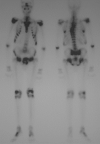Phosphaturic mesenchymal tumors: radiological aspects and suggested imaging pathway
- PMID: 34453276
- PMCID: PMC8702419
- DOI: 10.1007/s11547-021-01412-1
Phosphaturic mesenchymal tumors: radiological aspects and suggested imaging pathway
Abstract
Phosphaturic mesenchymal tumors (PMTs) are rare mesenchymal neoplasms of soft tissue or bone origin that can give rise to a challenge in diagnostic imaging. These tumors are frequently associated with tumor-induced osteomalacia, also called oncogenic osteomalacia, which is a rare paraneoplastic syndrome characterized by ectopic secretion of fibroblast growth factor 23, a hormone that regulates serum phosphate level. PMTs show polymorphic features on both radiological findings and histological examination, causing problems in diagnosis owing to their similarity with other mesenchymal tumors. Thus, this paper aims to describe radiological aspects of PMTs and suggest an imaging pathway for accurate diagnosis throughout the evidence from the literature review.
Keywords: Fibroblast growth factor 23; Oncogenic osteomalacia; Phosphaturic mesenchymal tumors; Tumor-induced osteomalacia.
© 2021. The Author(s).
Conflict of interest statement
The authors declare that they have no conflict of interest.
Figures










References
-
- Kaul M, Silverberg M, Dicarlo EF, Schneider R, Bass AR, Erkan D. Tumor-induced osteomalacia. Clin Rheumatol. 2007;26(9):1575–1579. - PubMed
-
- Shimada T, et al. FGF-23 is a potent regulator of vitamin D metabolism and phosphate homeostasis. J Bone Miner Res. 2004;19(3):429–435. - PubMed
-
- Florenzano P, Hartley IR, Jimenez M, Roszko K, Gafni RI, Collins MT. Tumor-induced osteomalacia. Calcif Tissue Int. 2021;108(1):128–142. - PubMed
-
- McCANCE RA. Osteomalacia with Looser's nodes (Milkman's syndrome) due to a raised resistance to vitamin D acquired about the age of 15 years. Q J Med. 1947;16(1):33–46. - PubMed
Publication types
MeSH terms
Supplementary concepts
LinkOut - more resources
Full Text Sources
Medical

